Do You Deadlift?
Maybe the better question is: Should You Deadlift? I have had many conversations about the Deadlift in my career. People LOVE to use this as a main-stay conditioning exercise. But, as PT who specializes in prevention, the Deadlift is just not a favorite of mine. Because Deadlift is intrinsically bad? NO, not all. The fact is that most people have no idea how to execute this correctly. And, poor execution leads to a host of injuries including: back sprains, hamstring sprains and tears, and disc herniations. The problem? Most people think the Deadlift is driven from the hamstring or back. NOPE! I know you’re thinking: “Well, I always feel my hamstrings when I do the exercise.?! And, sometimes I feel my back.” (If you feel your back during a deadlift STOP DOING THE EXERCISE NOW!) Yes, the hamstrings are very engaged, but they do not drive or stabilize the movement. And because most people don’t know this, injury is the result. So what does drive the Deadlift?
The Romanian DeadLift
First things first. Let’s all get on the same page as to the Deadlift I’m speaking of. There are several varieties, especially in the world of heavy lifting. I’m referring to the most common deadlift my patients ask me about. It’s called the Romanian deadlift and the one commonly taught in fitness gyms and in magazine articles. I just grabbed this photo from Women’s Health and Fitness. This is the one I’m referencing.
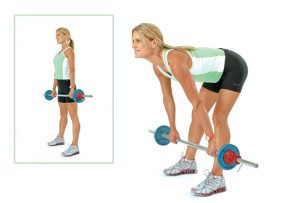
In order to make this blog post concise, I will pick on two main actions of the deadlift: pelvic and trunk control. Why these two? Because they are the main areas of injury.
A little anatomy review.
The Pelvic/Hip Complex
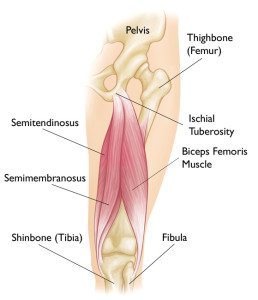 THE HAMSTRINGS
THE HAMSTRINGS
The primary role of the hamstrings are to flex or bend the knees. You know, kick your heel to your butt. The tendons attach at the bottom of the pelvis and travel down to insert on the lower leg. There are 3 hamstring muscles (semitendionosus, semimembranosus and biceps femoris). These muscles are long, stringy and excellent at moving the knee. However, a lot of people use the Deadift as a primary way to train the hamstrings. Not the best plan.
Some argue that the Deadlift stretches the hamstrings and works them eccentrically. (An eccentric contraction is one that lengthens the muscle while strengthening it). This is true, but only if those hamstrings have enough pliability or “give” in them to be lengthened while strengthened. Loading a heavy weight to tight hamstring during a Deadlift can lead to tears. So, if you’re looking for my hamstring length, maybe stretch??
Training the hamstrings eccentrically is important, especially for runners. But, why not train these 3 muscles using hamstring curls (knee flexion) since that is their main role? How would you do that? Find a prone hamstring curl machine, curl your legs up on 1 count, slowly lower on 3 counts. This is a MUCH better way to train the hamstrings eccentrically.
Additionally, do you see anywhere in the anatomy that these muscles cross over the pelvis? No, me neither. If they don’t cross the pelvis, how can they be the main hip controllers during the exercise. Well, they’re not. The hamstrings just assist with their one tiny insertion point. Can you see why hamstring strains and tears are common if this is the only muscle people know to use?
THE GLUTES: MAXIMUS, MEDIUS AND MINIMUS
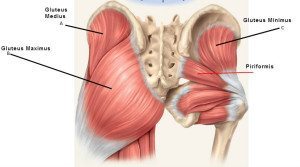 The primary role of the gluteus maximus (GMax) is hip extension (it moves the leg behind your pelvis/trunk). It’s that big, bulky muscle to the left. When you bend over to perform a Deadlift, what position are your hips in? Flexion. So, if GMax is the main hip extender, what muscle should you be using to bring yourself back up? That’s right. GMax not the hamstrings. And, do you see how this muscle crosses the pelvis and attaches to the leg? This is the main driver and stabilizer at the pelvis and hip during a Deadlift.
The primary role of the gluteus maximus (GMax) is hip extension (it moves the leg behind your pelvis/trunk). It’s that big, bulky muscle to the left. When you bend over to perform a Deadlift, what position are your hips in? Flexion. So, if GMax is the main hip extender, what muscle should you be using to bring yourself back up? That’s right. GMax not the hamstrings. And, do you see how this muscle crosses the pelvis and attaches to the leg? This is the main driver and stabilizer at the pelvis and hip during a Deadlift.
Gluteus medius (GMed) and its assistant gluteus minimus (GMin) are the “side glute” muscles. During the Deadlift, these muscles act to stabilize the pelvis and keep it level. Along with GMax, they are the base of the core and allow the trunk to move forward and back safely.
Does it now make sense now that the glutes are the main muscles controlling the pelvis forward and back and not the hamstrings? I hope so.
The Trunk Complex
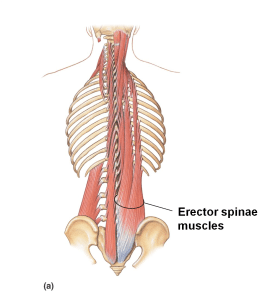 THE LUMBAR EXTENSORS
THE LUMBAR EXTENSORS
The erector spinae are the main movers or extenders of the spine when the spine is rounded forward. Is the spine rounded in a Deadlift? Gosh, I hope not!! During the Deadlift, these muscles work isometrically to give extra stability to the spine, but they are not the key players for trunk control. If you notice any pelvic tilt or feel any back pain during this exercise, the intrinsic stabilizers have been kicked off and now the erector spinae muscles are trying to stabilize the spine. This is unsafe and a back injury is lurking around the corner. Remember: please stop the exercise if you feel any pain in your back.
THE ABDOMINALS
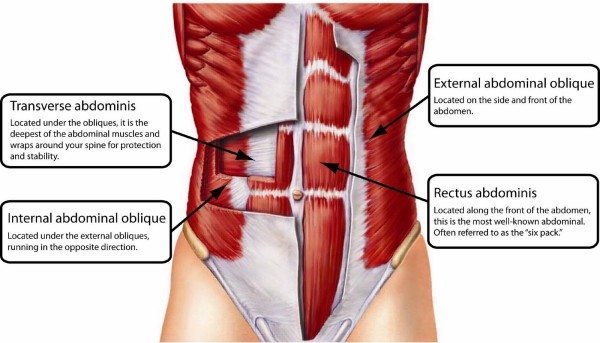 The intrinsic layers of the abdominals are the real players for safe trunk control. These are the inner two abdominal layers: transverse abdominis and internal abdominal oblique. When these muscles contract, they increase the intra-abdominal pressure and give stability to the spine. If these are not working well, the spine is VERY vulnerable to injury.
The intrinsic layers of the abdominals are the real players for safe trunk control. These are the inner two abdominal layers: transverse abdominis and internal abdominal oblique. When these muscles contract, they increase the intra-abdominal pressure and give stability to the spine. If these are not working well, the spine is VERY vulnerable to injury.
THE LUMBAR MULITIFIDI
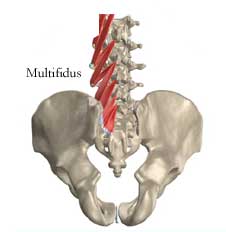
The lumbar multifidi (plural for multifidus) are segmental stabilizers of the spine. The attachments and insertions criss-cross multiple levels, giving it a very unique look and function. With the Deadlift, these tiny and important stabilizers work with the intrinsic core to maintain a neutral spine.
I hope it makes sense that the glutes and core are the main drivers and stabilizers in the Deadlift. And, if they aren’t working well you’re setting yourself up for injury.
This is a decent picture of good deadlift mechanics. I would just add, engage your core to ensure your spine is neutral.
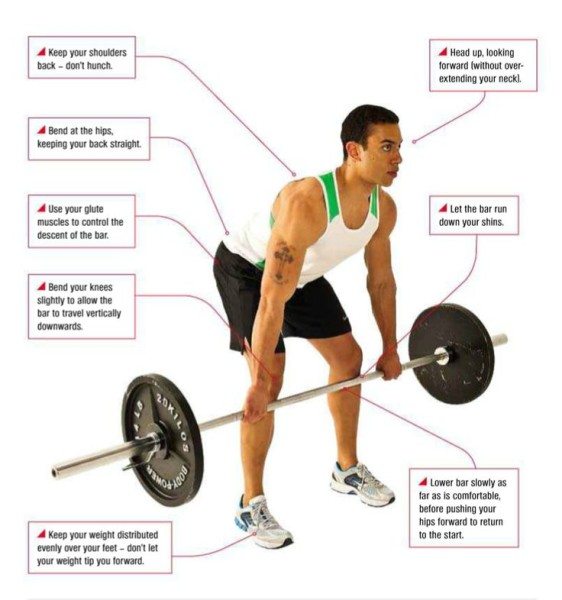
TAKE HOME POINTS
- The Deadlift is only safe to execute if you understand the main muscle drivers are the glutes and deep core
- To train the hamstrings eccentrically, use the prone hamstring curl machine instead of the Deadlift
- If you round your spine during the Deadlift, stop doing it now! That is a back injury waiting to happen.
Thank you for reading! If you enjoyed this post and found it helpful, please share so others can learn too.
© 2016 & Beyond. ALL BLOG CONTENT at duncansportspt.com by Lori Duncan PT
(This blog post was originally published January 2016 and updated May 2018)
BLOG TALK PODCAST:
Blog Talk – Do You Deadlift?
ABOUT THE AUTHOR
 Lori Duncan, DPT, MTC, CPT is a respected Physical Therapist, Manual Therapist and Pilates instructor in Lafayette, CO. Lori is passionate about preventive physical therapy and education and is a nationally recognized presenter. She can be reached at [email protected]. You can also follow Duncan Sports Therapy + Wellness on Facebook & Instagram for more free tips and information.
Lori Duncan, DPT, MTC, CPT is a respected Physical Therapist, Manual Therapist and Pilates instructor in Lafayette, CO. Lori is passionate about preventive physical therapy and education and is a nationally recognized presenter. She can be reached at [email protected]. You can also follow Duncan Sports Therapy + Wellness on Facebook & Instagram for more free tips and information.


“Additionally, do you see anywhere in the anatomy that these muscles cross over the pelvis? No, me neither. If they don’t cross the pelvis, how can they be the main hip controllers during the exercise. Well, they’re not.”
What on God’s green earth are you talking about? It isn’t relevant whether the hamstrings cross the pelvis, but whether they produce rotation about the hip joint, which they do.
Or, you could actually read the relevant research and realize that the deadlift, Romanian, conventional, sumo, or other, elicits very high hamstring activity.
Alternatively, you could continue to demonize an exercise based on falsified criteria.
Hi,
Thank you for your response and thank you for reading. The hamstrings to do not produce rotation, but they do help eccentrically control the ischial tub (where they insert) in space. The are stringy, long and their line of pull is linear, not rotary. As stated in the blog, the hamstrings are an assistant at the pelvis and flex the knee. The blog is meant to educate and help people understand that thinking of a dead lift as a hamstring activity is dangerous. Why? Because if people only think of the hamstring they have missed the main stabilizing component. With stability, movement is altered and inefficient. I see more hamstring and back injuries from dead lifts simply because people don’t understand the importance of the glute/core complex. I never stated that the hamstrings are not active, but hoping people will start to think of dead lifts differently to avoid unnecessary injury. Thanks.
“The are stringy, long and their line of pull is linear, not rotary.”
All lines of pull are, well, linear, and all motion in the body is translated into rotary motion about a fulcrum. In this case, the hamstrings are a prime mover in extending the hip during the deadlift. Yes, they attach to the ischial tuberosity, acting on the trunk through the pelvis. You can say they act on the lower limb or that they move the trunk on a fixed leg, but this is apparent hip extension regardless of your frame of reference.
Fair enough to make sure people know the deadlift is not just a hamstring exercise, but it is very much a hamstring exercise. Given that the hamstrings have two functions, it is likely best to train them with both hip extension and knee flexion. Additionally, there are regional differences in activation between these two movements (beyond short head of BF being used during knee flexion).
Of course, what someone does depends on need, and many do not need to deadlift on two feet. Single-leg will suffice for many (which is, in some ways, a better glute exercise, anyway).
Well, I agree with you since you say you’re talking about the Romanian deadlift. I’ve never been all that fond of that lift myself. The standard deadlift, on the other hand, is great. You just have to learn how to do it correctly, but that’s true for pretty much every lift isn’t it?
Hi Cesar,
Yes, thank you for getting the gist of the post. You have to fire the right muscles to do the lift correctly! As a PT when I’m reviewing the dead lift with my patients, most of them have no clue that it is driven from the glutes and core. Thanks for the comment!